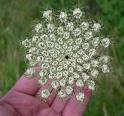 Also called wild carrot, bird’s nest, and bishop’s lace, this herbaceous biennial is a member of the parsley family, Apiaceae, that also includes celery, dill, and poison hemlock. It is also the plant from which all cultivated carrots were cultivated. A native of Europe, southwest Asia, and North Africa it naturalized in North America where it became invasive and now can be found in open grasslands, meadows, roadsides, abandon fields, waste areas, and degraded prairies. Plants grow 24-48″ tall and have leaves that are roughly triangular in shape, tripinnate, and finely divided. The small cream-colored flowers are carried in dense flat terminal umbels 3-4″ across from May to October. Some flowerheads have a single red to purple flower in the center which is believed to attract insects. As the flower heads mature they curl up to form a bird’s nest like structure. Care should be taken when handling the plant because the leaves can cause skin irritation in susceptible individuals. Queen Anne’s lace prefers full sun to part shade, and average to lean, moderately moist, well-drained soil in USDA Hardiness zones 3-9.
Also called wild carrot, bird’s nest, and bishop’s lace, this herbaceous biennial is a member of the parsley family, Apiaceae, that also includes celery, dill, and poison hemlock. It is also the plant from which all cultivated carrots were cultivated. A native of Europe, southwest Asia, and North Africa it naturalized in North America where it became invasive and now can be found in open grasslands, meadows, roadsides, abandon fields, waste areas, and degraded prairies. Plants grow 24-48″ tall and have leaves that are roughly triangular in shape, tripinnate, and finely divided. The small cream-colored flowers are carried in dense flat terminal umbels 3-4″ across from May to October. Some flowerheads have a single red to purple flower in the center which is believed to attract insects. As the flower heads mature they curl up to form a bird’s nest like structure. Care should be taken when handling the plant because the leaves can cause skin irritation in susceptible individuals. Queen Anne’s lace prefers full sun to part shade, and average to lean, moderately moist, well-drained soil in USDA Hardiness zones 3-9.
Native alternatives include:
Lyall’s Angelica (Angelica arguta)
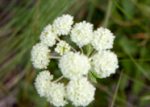 Lyall’s angelica is a herbaceous perennial native to western North America where it grows in meadows, marshes, bottomlands, along streams, and in montane zones from Alaska, south to Wyoming and California. Growing 2-7′ tall from a large often divided taproot, the plant has a stout, hallow, vertically ribbed stem and alternate somewhat triangular leaves that sheath the stem. Each leaf is divided into elliptical to lanceolate, sharply toothed leaflets 2-6″ long and has a pungent parsley or celery scent when crushed. From late spring to mid summer small white to pinkish flowers appear in large flat-topped compound umbels. USDA Hardiness Zones 4-8
Lyall’s angelica is a herbaceous perennial native to western North America where it grows in meadows, marshes, bottomlands, along streams, and in montane zones from Alaska, south to Wyoming and California. Growing 2-7′ tall from a large often divided taproot, the plant has a stout, hallow, vertically ribbed stem and alternate somewhat triangular leaves that sheath the stem. Each leaf is divided into elliptical to lanceolate, sharply toothed leaflets 2-6″ long and has a pungent parsley or celery scent when crushed. From late spring to mid summer small white to pinkish flowers appear in large flat-topped compound umbels. USDA Hardiness Zones 4-8
Hairy Angelica (Angelica venenosa)
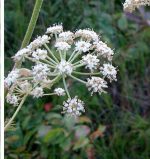 Hairy angelica is a herbaceous perennial native to Eastern US from Massachusetts to Minnesota, south to Florida, Mississippi and Arkansas where it grows in open woods, clearings, meadows, glades, and roadsides. Plants grow 1-4′ tall from a deep, branched taproot and have stems covered with fine white hairs at their extremities. The dark green leaves are 2-3 times compound and have elliptical to lanceolate toothed leaflets up to 2″ long. In summer, terminal flat-topped compound umbels of small white flowers appear on long somewhat hairy stalks. USDA Hardiness Zones 4-8. Photo Credit: Mason Brock
Hairy angelica is a herbaceous perennial native to Eastern US from Massachusetts to Minnesota, south to Florida, Mississippi and Arkansas where it grows in open woods, clearings, meadows, glades, and roadsides. Plants grow 1-4′ tall from a deep, branched taproot and have stems covered with fine white hairs at their extremities. The dark green leaves are 2-3 times compound and have elliptical to lanceolate toothed leaflets up to 2″ long. In summer, terminal flat-topped compound umbels of small white flowers appear on long somewhat hairy stalks. USDA Hardiness Zones 4-8. Photo Credit: Mason Brock
Large Boykinia (Boykinia major)
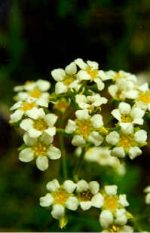 Large boykinia is a herbaceous perennial native to Oregon, Idaho, California, and Montana where it grows in moist meadows and riparian sites. Growing from a rhizomatous rootstock, plants are 1.6-3.3′ tall and have brown hairy stems covered with glands and leaves that up to 20″ long and carried on petioles up to 14″ long. Each palmate leaf is deeply divided into 3 to 7 lobes with sharply toothed margins. In summer panicles of small white flowers appear on thin stems up to 36″ long. USDA Hardiness Zones 5-7
Large boykinia is a herbaceous perennial native to Oregon, Idaho, California, and Montana where it grows in moist meadows and riparian sites. Growing from a rhizomatous rootstock, plants are 1.6-3.3′ tall and have brown hairy stems covered with glands and leaves that up to 20″ long and carried on petioles up to 14″ long. Each palmate leaf is deeply divided into 3 to 7 lobes with sharply toothed margins. In summer panicles of small white flowers appear on thin stems up to 36″ long. USDA Hardiness Zones 5-7
Cow Parsnip (Heracleum maximum)
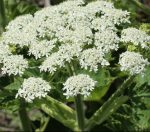
Cow parsnip is a herbacious biennial native to most of North America from subboreal Canada, south to North Carolina, New Mexico, and California where it grows in woodlands, forest openings, grasslands, meadows, stream and river edges, wet ditches,and along roadsides. Plants have a tap root or thick cluster of roots and a stout, hallow, light green stem 4- 8′ tall. The stem has verticle ridges, is usually unbranched, and is covered with white hairs. The lower leaves are carried on petioles 3-10″ long, are up to 20″ across, and are divided into three oval coarsely-toothed, lobed leaflets, 4-12″ long. Upper leaves are up to 4″ long, have 3 lobes, and are coarsely toothed. Terminal flat-headed compound umbels up to 12″ across appear from late spring to mid summer during the second year. USDA Hardiness Zones 3-8
Cowbane (Oxypolis rigidior)
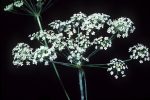 Also called pig-potato and stiff cowbane, this herbaceous perennial is native to eastern US from New York south to Florida and west to Texas and Minnesota where it grows in wet areas such as bogs, seeps, marshes, swamp, fens, wet prairies, and streambanks. Plants grow 2-6′ tall from a fleshy rootsystem and have sparingly branched, medium green stems with conspicuous veining. The medium green compound leaves are up to 12′ long and have 5 to 11 leaflets 1.5- 4″ long. Flat umbels 3-6″ across appear from late summer to fall and are comprised of 10-25 umbellets with up to 25 flowers each. Each flower is 1/8″ across and has 5 white spreading petals. Both foliage and roots are toxic to mammals.USDA Hardiness Zones 4-8. Photo Credit: Wikipedia
Also called pig-potato and stiff cowbane, this herbaceous perennial is native to eastern US from New York south to Florida and west to Texas and Minnesota where it grows in wet areas such as bogs, seeps, marshes, swamp, fens, wet prairies, and streambanks. Plants grow 2-6′ tall from a fleshy rootsystem and have sparingly branched, medium green stems with conspicuous veining. The medium green compound leaves are up to 12′ long and have 5 to 11 leaflets 1.5- 4″ long. Flat umbels 3-6″ across appear from late summer to fall and are comprised of 10-25 umbellets with up to 25 flowers each. Each flower is 1/8″ across and has 5 white spreading petals. Both foliage and roots are toxic to mammals.USDA Hardiness Zones 4-8. Photo Credit: Wikipedia
Wild Quinine (Parthenium integrifolium)
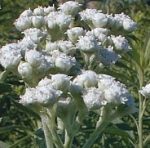 Also called American feverfew, wild quinine is a herbaceous perennial native to eastern North America from Quebec to Ontario, south to Florida and Texas where it grows in prairies, fields, open wooded areas, rocky woods, and hillsides. Plants grow 2-4′ tall and have stiff hairy stems and coarsely-toothed aromatic leaves covered with short bristly hairs. From late spring to mid summer woolly-looking flat topped terminal corymbs of tiny white ray flowers appear. USDA Hardiness Zones 4-8
Also called American feverfew, wild quinine is a herbaceous perennial native to eastern North America from Quebec to Ontario, south to Florida and Texas where it grows in prairies, fields, open wooded areas, rocky woods, and hillsides. Plants grow 2-4′ tall and have stiff hairy stems and coarsely-toothed aromatic leaves covered with short bristly hairs. From late spring to mid summer woolly-looking flat topped terminal corymbs of tiny white ray flowers appear. USDA Hardiness Zones 4-8
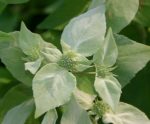 Also called short toothed mountain mint, this herbaceous perennial is native to Eastern North American from Maine to Michigan and Illinois, south to Florida and Texas, where it grows in woodlands, fields, meadows, grassy open spaces, and bogs. Growing 1-3′ tall from a rhizomatous root system, the plant has branched stems with dark green leaves 1-3″ long. The oval leaves have toothed margins and a strong spearmint aroma when crushed. From mid to late summer 1/2″ -2″ wide terminal flat-topped clusters of two-lipped tubular pink appear. The flowers are up to 1/2″ wide and are attractive to bees, beneficial wasps, moths, and butterflies. Showy silvery leaf-like bracts subtend the flower clusters and add to the ornamental attractiveness of the plant. USDA Hardiness Zones 4-8
Also called short toothed mountain mint, this herbaceous perennial is native to Eastern North American from Maine to Michigan and Illinois, south to Florida and Texas, where it grows in woodlands, fields, meadows, grassy open spaces, and bogs. Growing 1-3′ tall from a rhizomatous root system, the plant has branched stems with dark green leaves 1-3″ long. The oval leaves have toothed margins and a strong spearmint aroma when crushed. From mid to late summer 1/2″ -2″ wide terminal flat-topped clusters of two-lipped tubular pink appear. The flowers are up to 1/2″ wide and are attractive to bees, beneficial wasps, moths, and butterflies. Showy silvery leaf-like bracts subtend the flower clusters and add to the ornamental attractiveness of the plant. USDA Hardiness Zones 4-8